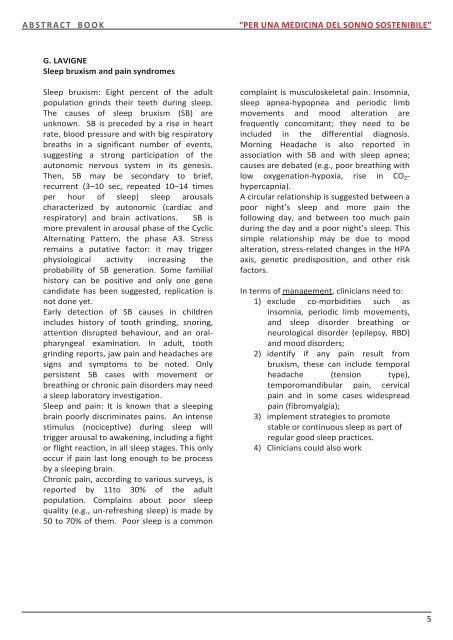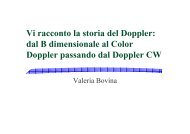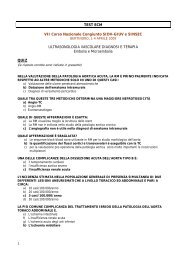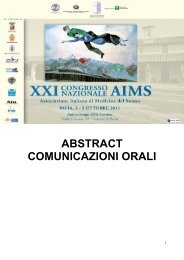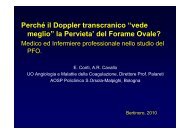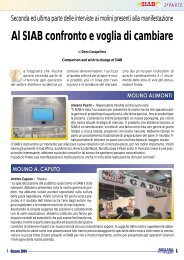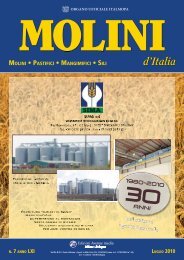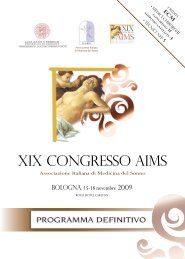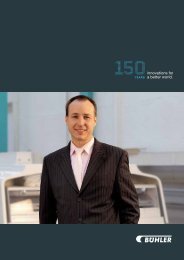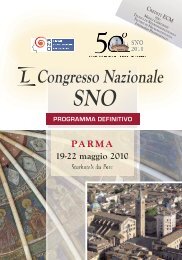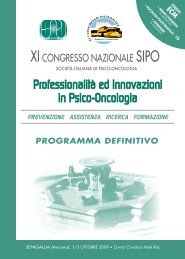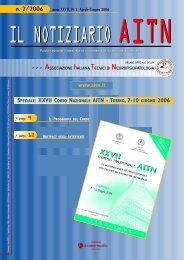CONGRESSO NAZIONALE - Avenue media
CONGRESSO NAZIONALE - Avenue media
CONGRESSO NAZIONALE - Avenue media
You also want an ePaper? Increase the reach of your titles
YUMPU automatically turns print PDFs into web optimized ePapers that Google loves.
a b s t r a c t b o o k<br />
G. LAVIGNE<br />
Sleep bruxism and pain syndromes<br />
Sleep bruxism: Eight percent of the adult<br />
population grinds their teeth during sleep.<br />
The causes of sleep bruxism (SB) are<br />
unknown. SB is preceded by a rise in heart<br />
rate, blood pressure and with big respiratory<br />
breaths in a significant number of events,<br />
suggesting a strong participation of the<br />
autonomic nervous system in its genesis.<br />
Then, SB may be secondary to brief,<br />
recurrent (3–10 sec, repeated 10–14 times<br />
per hour of sleep) sleep arousals<br />
characterized by autonomic (cardiac and<br />
respiratory) and brain activations. SB is<br />
more prevalent in arousal phase of the Cyclic<br />
Alternating Pattern, the phase A3. Stress<br />
remains a putative factor: it may trigger<br />
physiological activity increasing the<br />
probability of SB generation. Some familial<br />
history can be positive and only one gene<br />
candidate has been suggested, replication is<br />
not done yet.<br />
Early detection of SB causes in children<br />
includes history of tooth grinding, snoring,<br />
attention disrupted behaviour, and an oralpharyngeal<br />
examination. In adult, tooth<br />
grinding reports, jaw pain and headaches are<br />
signs and symptoms to be noted. Only<br />
persistent SB cases with movement or<br />
breathing or chronic pain disorders may need<br />
a sleep laboratory investigation.<br />
Sleep and pain: It is known that a sleeping<br />
brain poorly discriminates pains. An intense<br />
stimulus (nociceptive) during sleep will<br />
trigger arousal to awakening, including a fight<br />
or flight reaction, in all sleep stages. This only<br />
occur if pain last long enough to be process<br />
by a sleeping brain.<br />
Chronic pain, according to various surveys, is<br />
reported by 11to 30% of the adult<br />
population. Complains about poor sleep<br />
quality (e.g., un-refreshing sleep) is made by<br />
50 to 70% of them. Poor sleep is a common<br />
“per una medicina del sonno sostenibile”<br />
complaint is musculoskeletal pain. Insomnia,<br />
sleep apnea-hypopnea and periodic limb<br />
movements and mood alteration are<br />
frequently concomitant; they need to be<br />
included in the differential diagnosis.<br />
Morning Headache is also reported in<br />
association with SB and with sleep apnea;<br />
causes are debated (e.g., poor breathing with<br />
low oxygenation-hypoxia, rise in CO2hypercapnia).<br />
A circular relationship is suggested between a<br />
poor night’s sleep and more pain the<br />
following day, and between too much pain<br />
during the day and a poor night’s sleep. This<br />
simple relationship may be due to mood<br />
alteration, stress-related changes in the HPA<br />
axis, genetic predisposition, and other risk<br />
factors.<br />
In terms of management, clinicians need to:<br />
1) exclude co-morbidities such as<br />
insomnia, periodic limb movements,<br />
and sleep disorder breathing or<br />
neurological disorder (epilepsy, RBD)<br />
and mood disorders;<br />
2) identify if any pain result from<br />
bruxism, these can include temporal<br />
headache (tension type),<br />
temporomandibular pain, cervical<br />
pain and in some cases widespread<br />
pain (fibromyalgia);<br />
3) implement strategies to promote<br />
stable or continuous sleep as part of<br />
regular good sleep practices.<br />
4) Clinicians could also work<br />
5<br />
5


